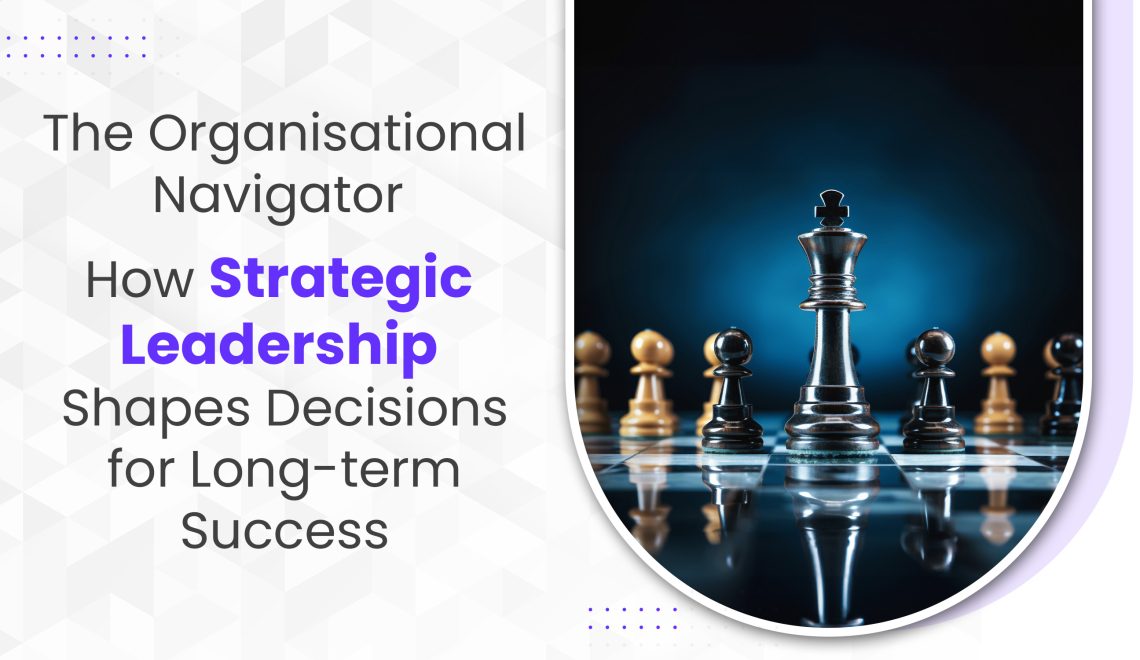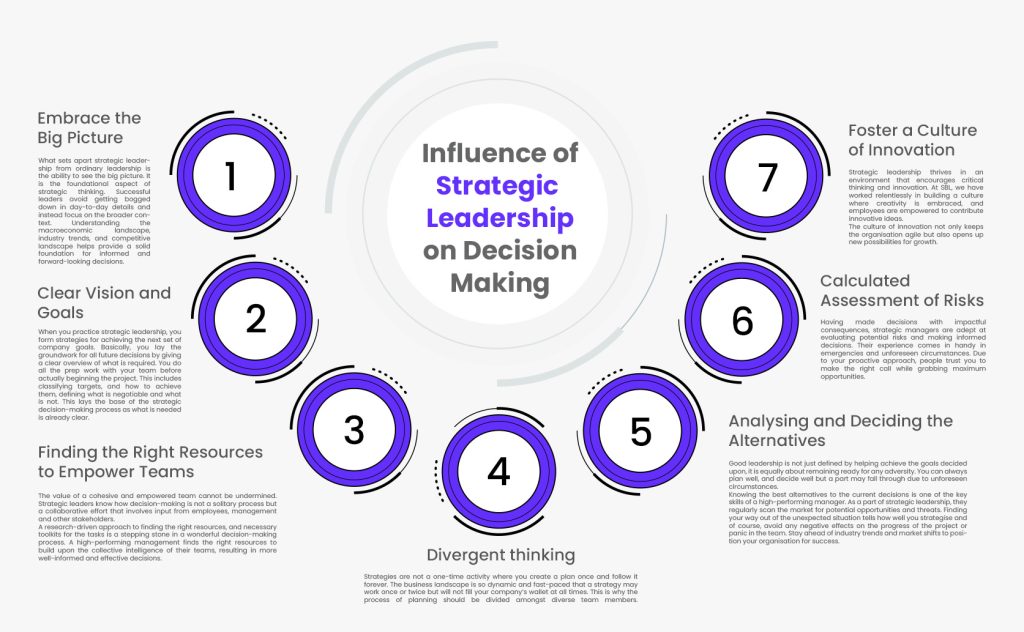
For those who consider strategic thinking as a managerial buzzword, it is not! It is here to help managers transform their leadership to lead with foresight and purpose.
In the dynamic landscape of modern business, when strategic thinking is combined with good leadership, the outcome you get is strategic leadership. True leaders are team managers who form strategies to achieve business goals and influence people to believe in what they believe. Be it small goals or big-scale visions, they inspire people to achieve the organisation’s mission with passion and humility. In this blog, we will discuss how strategic leadership influences decision-making within an organisation and its indispensable role in achieving sustained success.
Influence of Strategic Leadership on Decision Making
Being a high-profile manager in SBL, I have witnessed the profound impact of strategic leadership on decision-making processes. Strategic leadership goes beyond traditional management roles and helps you make the right decisions at the right time. Here’s how:
1. Embrace the Big Picture:
What sets apart strategic leadership from ordinary leadership is the ability to see the big picture. It is the foundational aspect of strategic thinking.

Successful leaders avoid getting bogged down in day-to-day details and instead focus on the broader context. Understanding the macroeconomic landscape, industry trends, and competitive landscape helps provide a solid foundation for informed and forward-looking decisions.
2. Clear Vision and Goals
When you practice strategic leadership, you form strategies for achieving the next set of company goals. Basically, you lay the groundwork for all future decisions by giving a clear overview of what is required. You do all the prep work with your team before actually beginning the project. This includes classifying targets, and how to achieve them, defining what is negotiable and what is not. This lays the base of the strategic decision-making process as what is needed is already clear.
This alignment of decisions, whether big or small, creates a unified and purpose-driven culture within the company. Strategic leaders thus understand the importance of reinforcing the connection between strategic decisions and the broader management vision.
3. Finding the Right Resources to Empower Teams
The value of a cohesive and empowered team cannot be undermined. Strategic leaders know how decision-making is not a solitary process but a collaborative effort that involves input from employees, management and other stakeholders.
A research-driven approach to finding the right resources, and necessary toolkits for the tasks is a stepping stone in a wonderful decision-making process. A high-performing management finds the right resources to build upon the collective intelligence of their teams, resulting in more well-informed and effective decisions.
4. Divergent thinking
Strategies are not a one-time activity where you create a plan once and follow it forever. The business landscape is so dynamic and fast-paced that a strategy may work once or twice but will not fill your company’s wallet at all times. This is why the process of planning should be divided amongst diverse team members.
This process will help you gather a pool of different perspectives with diverse ways to tackle a single problem. Eventually, the task of a manager will be to weigh the pros and cons of each solution and choose the best one from the list.
Remember an inclusive and empowered workplace inspires unique and out-of-the-box strategies and solutions that can be of great help in the constantly changing market terrain.
5. Analysing and Deciding the Alternatives:
Good leadership is not just defined by helping achieve the goals decided upon, it is equally about remaining ready for any adversity. You can always plan well, and decide well but a part may fall through due to unforeseen circumstances.
Knowing the best alternatives to the current decisions is one of the key skills of a high-performing manager. As a part of strategic leadership, they regularly scan the market for potential opportunities and threats. Finding your way out of the unexpected situation tells how well you strategise and of course, avoid any negative effects on the progress of the project or panic in the team. Stay ahead of industry trends and market shifts to position your organisation for success.
6. Calculated Assessment of Risks
Having made decisions with impactful consequences, strategic managers are adept at evaluating potential risks and making informed decisions. Their experience comes in handy in emergencies and unforeseen circumstances. Due to your proactive approach, people trust you to make the right call while grabbing maximum opportunities.
7. Foster a Culture of Innovation:
Strategic leadership thrives in an environment that encourages critical thinking and innovation. At SBL, we have worked relentlessly in building a culture where creativity is embraced, and employees are empowered to contribute innovative ideas.
The culture of innovation not only keeps the organisation agile but also opens up new possibilities for growth.
Summary
The ability to pivot when necessary is a hallmark of strategic leadership.
As strategic leadership involves aligning decisions with organisational goals, envisioning the future and setting a clear direction, it influences decision-making heavily.
Each action has to be planned well in advance and then decided upon. Leaders who include their teams in the decision-making process, develop a thorough plan of action, easily navigating the complexities of the business world.
Follow me on LinkedIn
Frequently Asked Questions
1. What is strategic thinking in leadership?
Strategic thinking is the ability of leaders to envision the future, make decisions that align with long-term objectives, and navigate the complexities of an ever-evolving business landscape. Strategic leaders are those who have a clear and compelling vision for the future of the organisation. They understand where the company is headed and articulate a roadmap analyzing market trends, anticipating challenges, and identifying growth opportunities.
2. Which type of decisions are made to implement the strategic decisions?
The implementation of strategic decisions involves making a series of operational and tactical decisions that are more specific, detail-oriented, and aimed at executing the broader strategic plan. For example, decisions related to processes and procedures, resource allocation, team assignments and performance metrics.




This post is truly a good one it helps new internet users, who are wishing for blogging. https://www.waste-ndc.pro/community/profile/tressa79906983/
I’m not sure why but this blog is loading very slow for me.
Is anyone else having this issue or is it a issue on my
end? I’ll check back later and see if the problem stil exists. https://Digital-Techss.blogspot.com/2024/04/efficiency-or-innovation-dilemma-for.html
In fact no matter if someone doesn’t understand afterward its uup tto other people that
they will assist, so here it occurs. https://Crypto-History.Mystrikingly.com/